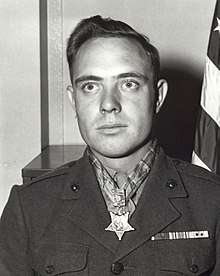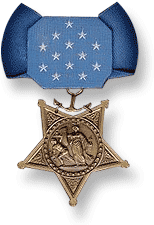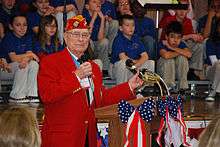Hershel W. Williams
| Hershel Woodrow Williams | |
|---|---|
 Williams as a corporal in 1945 | |
| Nickname(s) | "Woody" |
| Born |
October 2, 1923 Quiet Dell, West Virginia, U.S. |
| Allegiance |
|
| Service/ |
|
| Years of service | 1943-1945, 1948-1949, 1954-1969 |
| Rank | Chief warrant officer 4 |
| Unit | 1st Battalion, 21st Marine Regiment, 3rd Marine Division |
| Battles/wars | |
| Awards |
|
| Other work |
Veterans Administration Hershel Woody Williams Medal of Honor Foundation |
| Website | http://www.hwwmohf.org/ |
Hershel Woodrow "Woody" Williams (born October 2, 1923) is a retired United States Marine Corps warrant officer and United States Department of Veterans Affairs veterans service representative who received the United States military's highest decoration for valor—the Medal of Honor—for heroism above and beyond the call of duty during the Battle of Iwo Jima in World War II. He and three soldiers are the only living Medal of Honor recipients from that war. In addition, he is the only surviving Marine to have received the Medal of Honor during the Second World War, and is the only surviving Medal of Honor recipient from the Pacific theater of the war.
Early life
Williams, the youngest of eleven children, was born and raised on a dairy farm in Quiet Dell, West Virginia, on October 2, 1923.[1][2] He worked a series of odd jobs in the area, including as a truck driver for W.S. Harr Construction Company of Fairmont, West Virginia and as a taxi driver. When Pearl Harbor was attacked, he was working in Montana as a Civilian Conservation Corps enrollee.[3]
Career
Williams tried to enlist in the Marine Corps in 1942, but was told he was too short for service. After the height regulations were changed in early 1943, he successfully enlisted in the Marine Corps Reserve in Charleston, West Virginia, on May 26.[4][5]
Williams received his recruit training at Marine Corps Recruit Depot San Diego, California. Upon completion, he was sent to the Camp Elliott training center in San Diego, where he joined the tank training battalion on August 21, 1943. The following month he was transferred to the training center's infantry battalion for instruction as a demolition man and in the use of flamethrowers.[4]
Williams was assigned to the 32nd Replacement Battalion on October 30, 1943, and left for New Caledonia in the southwest Pacific on December 3 aboard the M.S. Weltey Reden.[6]In January 1944, he joined Company C, 1st Battalion, 21st Marine Regiment, 3rd Marine Division at Guadalcanal.[6]{[4] In July and August 1944, he was attached to Headquarters Company and participated in action against the Japanese during the Battle of Guam. In October, he rejoined Company C.[4][6]
Medal of Honor action
Williams' next and final campaign was at the Battle of Iwo Jima, where he distinguished himself with actions "above and beyond the call of duty" – for which he would be awarded the Medal of Honor. On February 21, 1945, he landed on the beach with the 1st Battalion, 21st Marines. Williams, by then a corporal, distinguished himself two days later when American tanks, trying to open a lane for infantry, encountered a network of reinforced concrete pillboxes.[4] Williams went forward alone with his 70-pound (32 kg) flamethrower to attempt the reduction of devastating machine gun fire from the unyielding positions.[4][5]

Covered by only four riflemen, he fought for four hours under terrific enemy small-arms fire and repeatedly returned to his own lines to prepare demolition charges and obtain serviced flame throwers. He returned to the front, frequently to the rear of hostile emplacements, to wipe out one position after another.[4] At one point, a wisp of smoke alerted him to the air vent of a Japanese bunker, and he approached close enough to put the nozzle of his flamethrower through the hole, killing the occupants.[5] On another occasion, he was charged by enemy riflemen who attempted to stop him with bayonets and he killed them with a burst of flame from his weapon.[4]
These actions occurred on the same day that two flags were raised on Mount Suribachi, and Williams, about one thousand yards away from the volcano, was able to witness the event.[7][5] He fought through the remainder of the five-week-long battle even though he was wounded on March 6 in the leg by shrapnel, for which he was awarded the Purple Heart.[4]
In September 1945, he returned to the United States, and on October 1 he joined Marine Corps Headquarters in Washington, D.C. He and thirteen other servicemen were presented the Medal of Honor by President Harry S. Truman on October 5, 1945, at the White House.[4]
On October 22, 1945, he was transferred to the Marine Barracks, Naval Training Center Bainbridge, Maryland, for discharge. He was honorably discharged from the Marine Corps Reserve on November 6, 1945.
Post-war service
In March 1948, he reenlisted in the inactive Marine Corps Reserve, but was again discharged on August 4, 1949.[4]
On October 20, 1954, he joined the Organized Marine Reserve when the 98th Special Infantry Company was authorized by Headquarters Marine Corps to be located at Clarksburg, West Virginia. He transferred to the Marine Corps Reserve's 25th Infantry Company in Huntington, West Virginia on June 9, 1957, later becoming the (Interim) Commanding Officer of that unit as a warrant officer on June 6, 1960. He was designated the Mobilization Officer for the 25th Infantry Company and surrounding Huntington area on June 11, 1963.[4]
He was advanced through the warrant officer ranks during his time in the Marine Corps Reserve until reaching his final rank of Chief Warrant Officer 4 (CWO4). Although CWO4 Williams technically did not meet retirement requirements, he was honorarily retired from the Marine Corps Reserve in 1969 after approximately 17 years of service.[4]
Awards and decorations
Williams' military decorations and awards include:
| 1st row | Medal of Honor | Purple Heart | ||
|---|---|---|---|---|
| 2nd row | Navy Presidential Unit Citation | Navy Unit Commendation | Selected Marine Corps Reserve Medal with two service stars | |
| 3rd row | American Campaign Medal | Asiatic-Pacific Campaign Medal with two 3⁄16" bronze stars |
||
Medal of Honor citation
Williams' Medal of Honor citation reads:

CORPORAL HERSHEL W. WILLIAMS
UNITED STATES MARINE CORPS RESERVE
- for service as set forth in the following
- CITATION:
For conspicuous gallantry and intrepidity at the risk of his life above and beyond the call of duty as Demolition Sergeant serving with the First Battalion, Twenty-First Marines, Third Marine Division, in action against enemy Japanese forces on Iwo Jima, Volcano Island, 23 February 1945. Quick to volunteer his services when our tanks were maneuvering vainly to open a lane for the infantry through the network of reinforced concrete pillboxes, buried mines and black, volcanic sands, Corporal Williams daringly went forward alone to attempt the reduction of devastating machine-gun fire from the unyielding positions. Covered only by four riflemen, he fought desperately for four hours under terrific enemy small-arms fire and repeatedly returned to his own lines to prepare demolition charges and obtain serviced flame throwers, struggling back, frequently to the rear of hostile emplacements, to wipe out one position after another. On one occasion he daringly mounted a pillbox to insert the nozzle of his flame thrower through the air vent, kill the occupants and silence the gun; on another he grimly charged enemy riflemen who attempted to stop him with bayonets and destroyed them with a burst of flame from his weapon. His unyielding determination and extraordinary heroism in the face of ruthless enemy resistance were directly instrumental in neutralizing one of the most fanatically defended Japanese strong points encountered by his regiment and aided in enabling his company to reach its' [sic] objective. Corporal Williams' aggressive fighting spirit and valiant devotion to duty throughout this fiercely contested action sustain and enhance the highest traditions of the United States Naval Service.[8]
Civilian life and service

After World War II, Williams accepted a job as a Veterans Affairs counselor and retired with thirty-three years service.[7]
Williams struggled with the after-effects of combat stress until 1962, when he experienced a religious renewal. He later served as chaplain of the Congressional Medal of Honor Society for 35 years.[5] He was also a member of the Sons of the American Revolution and the Marine Corps League.
On February 2, 2011, Williams appeared on an episode of Sons of Guns where his unservicable flamethrower was refurbished back to working condition. The episode ended with Williams successfully firing the weapon at the age of 87.
Williams' Medal of Honor is on display at the Pritzker Military Museum & Library in Chicago.[9][10]
In 2010, the not-for-profit Hershel Woody Williams Congressional Medal of Honor Education Foundation, Inc. was established "to honor Gold Star Families, relatives, and Gold Star Children who have sacrificed a loved one in the service of their country."[11] Williams currently serves on the Foundation's Founders Advisory Board.[12]
Other honors
In 1965, Williams received West Virginia's Distinguished Service Medal. In 1967, he was honored by the Veteran's Administration with the Vietnam Service Medal for service as a civilian counselor to the armed forces. In 1999, he was added to the City of Huntington Foundation's "Wall of Fame". He received the 2014 Founder's Award for extraordinary contributions to the mission of the Pritzker Military Museum & Library and the preservation of the heritage of the Citizen Soldier.[13]
Named in his honor:
- Hershel "Woody" Williams VFW (Veterans of Foreign Wars) Post 7048 in Fairmont, West Virginia; 1310 Morgantown Ave. Fairmont WV 26554.
- the West Virginia National Guard Armory in Fairmont, West Virginia;
- a bridge at Barboursville, West Virginia; and
- an athletic field at Huntington, West Virginia.
- USNS Hershel "Woody" Williams, a Mobile Landing Platform to be built by General Dynamics NASSCO at their San Diego shipyard.[14] In August 2016, Williams was joined by Edward Byers at the ship's keel laying ceremony.[15]
On February 4, 2018, Williams along with 14 other living Medal of Honor recipients was honored at the Super Bowl LII during the coin toss. [16] He is the only living Marine Corps Medal of Honor recipient from World War II. Williams was selected to do the official coin toss for the game.[17] The coin toss ceremony set a record for most coin toss participants as Super Bowl LII was dedicated to them.
See also
References
- ↑ Karnath, Sgt. Melissa (February 27, 2015). "Humble farmer now legendary Marine". MCINCR - Marine Corps Base Quantico, USMC.
- ↑ "Hall of Fame: Hershel Woody Williams". West Virginia State Civilian Conservation Corps Museum Association.
- ↑ "Hershel W. 'Woody' Williams, WWII Medal of Honor recipient, on surviving Iwo Jima". Stars and Stripes. February 18, 2015.
- 1 2 3 4 5 6 7 8 9 10 11 12 13 "Chief Warrant Officer 4 Hershel Woodrow Williams, USMCR". Who's Who in Marine Corps History. United States Marine Corps History Division. Archived from the original on 2018-02-04. Retrieved July 7, 2010.
- 1 2 3 4 5 Anderson, Patrick B. (July 7, 2010). "Medal of Honor winner visits Winona veteran". Winona Daily News. Winona, Minnesota. Archived from the original on July 7, 2010.
- 1 2 3 "Hershel W. Williams". The Marine Corps Medal of Honor Recipients.
- 1 2 Pyles, Katherine (Winter 2016). "Hersehel "Woody" Williams" (pdf). Huntington Quarterly.
- ↑ "Cpl Hersel W. Williams, Medal of Honor, 1945, 1/21/3, Iwo Jima (Medal of Honor citation)". Marines Awarded the Medal of Honor. United States Marine Corps History Division. Archived from the original on 2007-02-20.
- ↑ "Catalog record for Hershel "Woody" Williams' Medal of Honor tapestry". Retrieved 9 March 2015.
- ↑ "Hershel "Woody" Williams Collection". Pritzker Military Museum & Library. Retrieved 9 March 2015.
- ↑ "Hershel Woody Williams Congressional Medal of Honor Education Foundation". hwwmohf.org. Retrieved 2018-02-04.
- ↑ "Foundation Officers, Board Members and Founder Advisors". Hershel Woody Williams Congressional Medal of Honor Education Foundation. Retrieved 2018-02-24.
- ↑ "Hershel "Woody" Williams Founders Award Remarks at the 2014 Liberty Gala". Pritzker Military Museum & Library. Retrieved 9 March 2015.
- ↑ "Secretary of the Navy Names Expeditionary Sea Base Ship". US Navy Public Affairs. Retrieved 14 January 2016.
- ↑ Jennewein, Chris (2 August 2016). "Iwo Jima Hero Honored at Keel Ceremony for Floating Marine Base". Times of San Diego. Retrieved 1 January 2017.
- ↑ Associated Press (January 25, 2018). "Super Bowl coin toss salute for Medal of Honor recipients". USA Today. Retrieved 2018-02-02.
- ↑ Mayer, Jennifer (February 3, 2018). "WWII Medal Of Honor Recipient To Give Super Bowl Coin Toss". CBS Minnesota. Retrieved 2018-02-04.
![]()
External links
| Wikimedia Commons has media related to Hershel W. Williams. |
- Official website
- "Interview at the Pritzker Military Museum & Library". Retrieved December 30, 2013.
- Appearances on C-SPAN
- Sons of Guns - Flamethrower Hero on YouTube — Williams successfully firing the flamethrower weapon